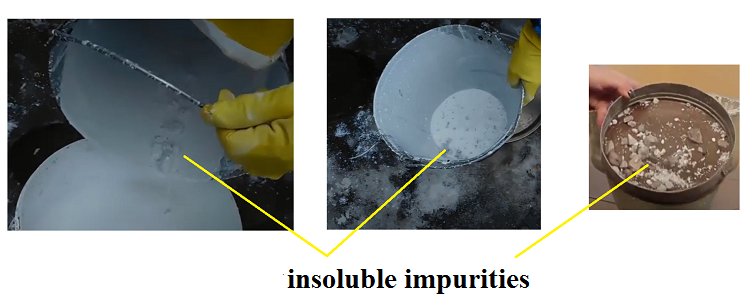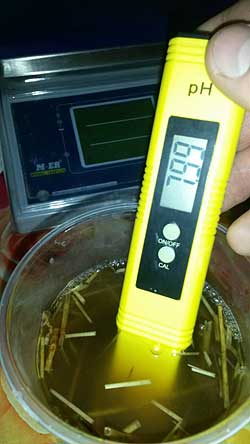
Table of Contents
Oyster mushrooms require a slightly alkaline substrate to reduce the risk of contamination. To achieve this, growers add alkaline substances such as lime or soda ash.
There is no need to add calcium carbonate (chalk) to oyster mushroom substrate. It does not regulate pH or moisture levels effectively.
The required amount depends on:
The main goal is to raise the pH level of the substrate to 7.8–8.5. This range is specific to oyster mushrooms—other mushrooms, such as shiitake, button mushrooms, or lion’s mane, require different pH levels.
Understanding pH and Alkalinity
pH measures the acid-base balance of a solution:
However, pH alone does not indicate the alkalinity of a solution—this refers to its ability to neutralize acids. Water with a naturally high pH (above 7) may already be suitable for oyster mushrooms, and if the substrate is made from fresh, clean husks, additional lime may not be needed.
If your tap or well water has an acidic pH (6.5 or lower), you must alkalize the water before using it for the oyster mushroom substrate.
Cold Pasteurization of Mushroom Substrate
Pasteurization is the process of heating raw materials with steam to destroy mold spores and bacteria. Since lime treatment does not involve heat, it cannot be called "pasteurization" or "lime pasteurization."
Instead, this process falls under chemical sterilization methods.
Chemical Sterilization of Mushroom Substrate
Chemical sterilization involves using alkaline or oxidizing agents to reduce contamination. Some of the methods include:
Sodium hypochlorite (bleach). While effective, it must be handled with extreme caution. Some mushroom growers use bleach together with lime. I do not recommend using it, but if you still decide to try, make sure you buy pure sodium hypochlorite without additives and do not use a solution with a concentration of more than 0.5%.
When Does Lime Treatment Work?
Lime disinfection is only suitable for small-scale production. It is not recommended for commercial mushroom farms.
This method can work if:
✔ Your raw materials are clean and dry (few mold spores present).
✔ The substrate colonizes without wet spots or mold.
However, if the substrate does not colonize properly or develops contamination, you will need to switch to a different disinfection method.
How to Use Lime for Disinfection
Soaking Time
Raw materials are typically soaked for 15 to 24 hours. The exact time depends on:
For high-quality oyster mushroom mycelium growth without contamination, the substrate needs a specific pH range.
After heat treatment, the substrate pH should be between 7.5 (preferably 7.8) and 8.5 (ideally 8.2).
At this pH level, oyster mushroom mycelium develops well, gradually acidifying the substrate as it grows.
Mold thrives in more acidic environments, so maintaining the right pH helps suppress its growth.
However, if the pH rises above 9, it can damage the mycelium.
In such an alkaline environment, mycelium growth slows down, allowing bacterial colonies to develop. This often leads to yellow spots where mycelium fails to grow.
More about mushroom block overgrowth problems
Again: There is no need to add calcium carbonate (chalk) to oyster mushroom substrate. It does not regulate pH or moisture levels effectively.

You need to determine this empirically.
First, test your water—in some regions, it is already alkaline enough that lime is not needed during hot water treatment.
However, if you still need to use lime:
A good starting point is 200 grams (7 oz) of quicklime per 100 kg (220 lb) of soaked raw material (or approximately 35-40 kg (77-88 lb) of dry raw material). Be sure to monitor the pH—if it is too low, increase the lime amount.
For example, try 300 grams (10,5 oz) instead.
Quicklime (like the one in the photo at the top of the article) must be high quality, meaning that when dissolved in water, it should not leave any undissolved pebbles. This type of lime is often called “fat lime” (at least, that's what it's called in my country), meaning it does not contain insoluble impurities.

You can also use pre-made lime paste if it is available in your region (usually found in hardware stores).
Always check the label!
The paste should contain only Ca(OH)₂ and should not have any dyes, plasticizers, or other additives.
Additionally, the lime must be calcium-based, not magnesian or dolomite lime. The latter two contain a high amount of magnesium oxide (MgO), which is not needed.
⚠️ Do not use soil-liming mixtures!
Ash will not effectively increase alkalinity. You can test this yourself by soaking husks with ash in water and then measuring the pH.
 The device in the photo is called a pH meter.
The device in the photo is called a pH meter.
First, you need to make an extract from the substrate.
Here's a short guide:
1. Take a glass jar, pour 250 ml of distilled water into it, and mark the water level.
2. Weigh out 25 grams of the substrate sample.
* If your country does not use the metric system, you can use approximately 1 cup (8 fl oz) of water and a little over 1 tablespoon of substrate.
3. Add the sample to the jar and fill it with water up to the marked level.
4. Stir the mixture and let it sit for 30–40 minutes before measuring the pH.
For straw-based substrates, it's best to cut the sample into 1–2 cm (1/2 -1 in) pieces using scissors before soaking. However, in practice, most growers don’t grind it.
When pasteurizing in a tunnel, pH is measured twice:
This method is very approximate.
A litmus strip is pressed against the steamed substrate on the inoculation table, and the color change gives a rough pH estimate. However, litmus tests do not show decimal values, which can be important for accuracy.
If a litmus test shows a pH below 7, you’ll know that more lime is needed. But without a precise pH meter, it will be difficult to determine the exact amount to add.
To successfully grow oyster mushrooms and prevent contamination, it's essential to control the pH of both the substrate and water used for processing.
- The ideal pH for oyster mushroom substrates is 7.8–8.2 after processing.
- Lime or soda ash can be used to raise pH, but the correct type and dosage depend on water quality and processing methods.
- Quicklime (CaO) and slaked lime (Ca(OH)₂) are suitable, but dolomitic and magnesium-rich lime should be avoided.
- A pH meter is the most accurate tool for monitoring pH, while litmus paper can provide only rough estimates.
- If the substrate's pH is too low, contamination risks increase. If it's too high, oyster mushroom mycelium may struggle to grow.
By following these guidelines, you can maintain an optimal pH balance and improve the success rate of your oyster mushroom cultivation.
